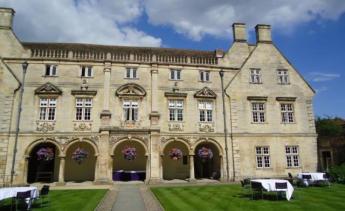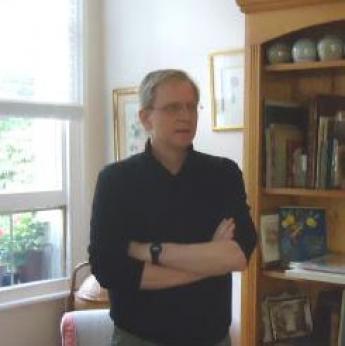Antiquarian Booksellers' Association Ash Rare Books
A World Much Changed - Laurence Worms in Conversation with Jim Hinck and Anne Marie Wall

By Laurence Worms
A thought that occurred to me when I found myself (in the Sedgwick Museum of Earth Sciences in Cambridge) standing next to the remains of a rhinoceros found in the nearby Fens. We think of our own modern world as much changed, but a Cambridgeshire landscape replete with mammoths, elephants and hippopotami, as once it was, represents change of a wholly different order. Adaptation to new realities has always been inescapable.
Museums have changed and are still changing. The Sedgwick is a perfect example. Half the displays are still of the old-fashioned kind – cases stuffed with curiosities, the fading hand-typed captions on slips of browning paper providing an arcane commentary only to those with enough knowledge to have written the captions themselves – experts speaking to experts, a closed world of refined knowledge and theory, a teaching aid only to professors and their most advanced students. The more modern displays have gone all in an opposite direction – bright, breezy, cheerful, interactive and apparently designed solely to amuse attention-challenged school-children (the children having been consulted, we are informed on one). Nothing in between and no real place here for an educated layman with an infinite respect for those quite brilliant nineteenth-century geologists who recovered the longer history of the earth. Both approaches valid for their time and place, but I can’t help but feel there must be a middle way.
No middle way at all at the Whipple Museum down the road. The captions wholly inadequate for anyone’s purposes (and yes I know you can go and consult a computer somewhere on the premises to find out more, but that’s not a viable option when there is more than one visitor). Thrilling to see some of the globes and the wonderful Adams orrery [it’s by the first George Adams (1709-1772) if anyone wants to write a decent caption]. Even when expanded beyond a single word, e.g. “telescope”, the captions told us nothing (and one or two even appeared to me to be just plain wrong). All so frustrating, so I left quietly before becoming one of those random shouty and embarrassing people we are all liable to encounter from time to time.
I needed to calm down. Across town to that haven of tranquillity, the Pepys Library at Magdalene. My last visit to Cambridge was to give a lecture on Pepys and the London Map Trade (and in particular that much-maligned mapmaker John Seller), so a special place for me. But a special place too for all of us who care about our history, our books, and the vital importance of keeping collections intact. Three thousand books in their contemporary bindings and contemporary book-presses – quite magnificent – and our knowledge of so many things would be so much the poorer without it. This is the essence of seventeenth-century England miraculously preserved. A magnet for scholars from all kinds of disciplines. The sum far greater than the parts. In a world much changed we need these anchors. Praise be that Magdalene has honoured this bequest and not taken to selling off on specious grounds some of the jewels (seven Caxtons, eight Wynkyn de Wordes, and seven Pynsons for starters). [Senate House Library please take note].
Time now to go and have tea with some booksellers. Anne Marie Wall and Jim Hinck (Hinck & Wall) are booksellers specialising in garden history and landscape architecture, early horticulture, and architecture and town-planning in general. Americans both, they have settled in Cambridge after a spell in Paris (where they retain a pied-à-terre). It’s an absorbing story.
They realised, much earlier than most of us, that with the advent of the internet, the book-trade’s traditional staples – the good, solid and essential books on any subject that everyone needs – were about to become a rapidly diminishing asset. As Jim puts it in a thoughtful recent post on his viaLibrian blog (required reading), “the pool of findable books exploded”. Their customers, often in American institutional libraries, were no longer going to want books they could find anywhere at the click of a mouse. The correct deduction was made that they would continue to want the rare and the unique, and that American holdings would generally be weakest in early non-English language material. To Europe they came to find just that material.
Adaptation in practice – no better example – and meanwhile, I’ve persuaded Anne Marie to give us a talk next year in the monthly book-collecting series at Senate House – title to be announced, but in their area of specialisation. We much look forward to that.
The Hinck & Wall analysis of how the rare book trade was changing, has changed – and changed forever – is unarguable. Adaptation is necessary for survival. I am not one of those who wants to turn the clock back and pretend this whole interweb thingy never happened. I blog, I tweet, cogito ergo sum. We were too polite to mention it over tea (and we can always bring this up in our Website Committee meetings in any case), but I do have a slight quibble over the precise form that adaptation should take. To surrender ourselves to the increasingly monopolistic and predatory embrace of Amazon and its subsidiary ABE seems to me to be not far removed from the survival strategy of the lemming. Amazon may seem to be as irresistible as one of the larger dinosaurs, but we know what happened to them – the internet seems perfectly adapted for the launch of an alternative. But Jim is a very, very, smart man and current thinking in the trade seems to side with him.
(Posted on The Bookhunter on Safari, presented here by permission of the author.)



